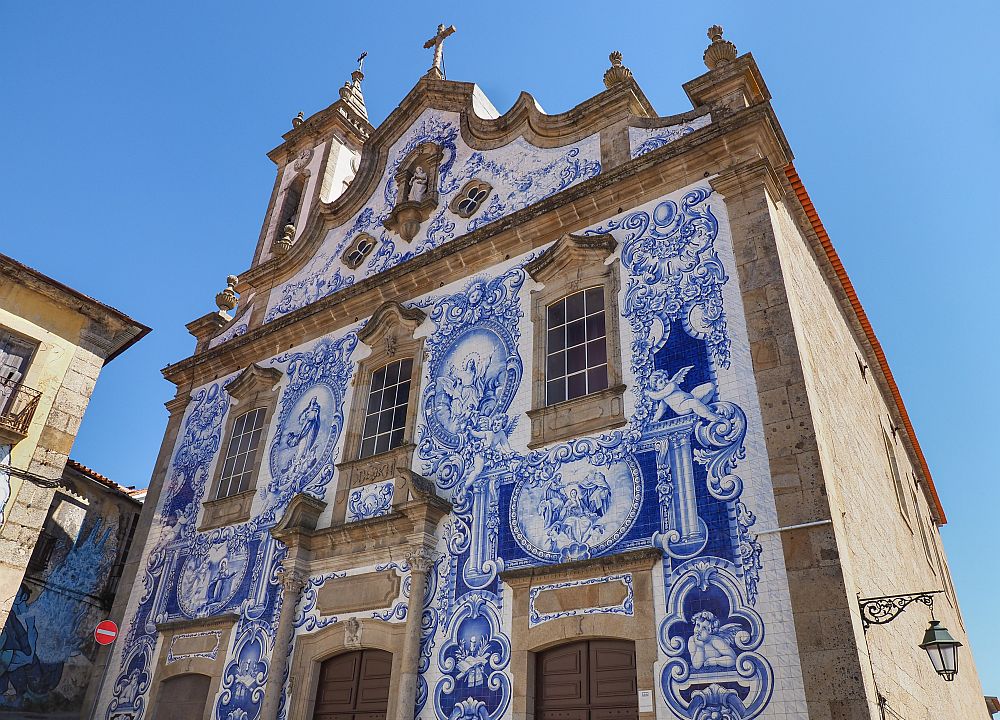
[Image above] Part of the façade of the iconic Church of Santa Maria Maior in Covilhã, Portugal. The façade is covered with blue and white azulejo tiles depicting the life of the Virgin Mary. Credit: LifeCollectionPhotography, Shutterstock
If you travel to Portugal, everywhere you turn, you will see gorgeous blue and white tiles adorning buildings, train stations, churches, and more. These tiles are called azulejos, which is derived from an Arabic term meaning “little polished stone.”
While azulejos today are viewed as beautiful decorations detailing Portuguese culture and history, azulejos did not originate in Portugal. Instead, these tiles trace their history to the Moors from North Africa, as explained below, and many other cultures since then have influenced the design of modern azulejos.
Azulejo origins
During the early 8th century, Muslim Berbers and Arabs conquered the Iberian Peninsula. They brought with them the concept of Islamic mosaic design, or alicatados, which features ceramic tiles arranged in intricate geometric patterns.
Between the 13th and 15th centuries, several Spanish cities started emerging as centers of innovation in tile production, including Seville. Around the early 16th century, the city became known for a faster production method where motifs were formed by pressing a metal or wooden mold into the unfired tile, leaving a motif delineated by thin ridges of clay. These ridges prevented the different colors from bleeding into each other during firing.
After a visit to Seville in 1503, Portugal’s King Manual I was so impressed that he brought back these techniques to his country. Tiles made in the same way were soon being installed on floors and walls, including the Arab Room of the Sintra National Palace.
Around the same time, potters from Italy began establishing workshops in Seville, bringing the maiolica techniques, permitting a much larger number of figurative themes in the design.
A history of many influences
During the 17th century, other countries also influenced tile design, including India (copied bird and branch patterns found on textiles), the Netherlands (Portugal imported their blue and white tiles from here until the country started making it themselves; the colors were modeled on that of Chinese porcelain), and France (panels in the Rococo style became popular). Portuguese exports of tiles to the Azores, Madeira, and Brazil also began during this time.
In the early 18th century, high demand from Portugal and its colony of Brazil led to mass production and the “Golden Age of the Azulejo.” Popular designs included historical and religious scenes, as well as landscapes. Panels with life-size figures of royalty and their servants also decorated palace entrances as a way to welcome visitors.
The catastrophic earthquake of 1755, which destroyed Lisbon, also led to some major changes. Marquês de Pombal, who was responsible for the reconstruction of the city, replaced the large original art works with smaller tiles having repetitive geometric patterns to save costs and expedite installation.
One structure that was not destroyed was the Sant’Anna tile factory, which began operation in 1741. The same handcrafted methods used at the time are still being applied, and most of its production is exported.
By the 18th century, Portugal was the European leader in tile production, producing more tile than any other country in numerous designs and for various purposes. However, the invasion of Napolean put a damper on production in the early 19th century.
Several decades after the war, Brazilian immigrants opened factories in Porto, producing high-relief tiles in one or two colors, which Portugal took over. Lisbon factories also adopted transfer printing, eventually using creamware blanks.
Portugal’s national museum devoted to azulejos, Museu Nacional do Azulejo, covers much of this history. Housed in the former Madre de Deus Convent (founded in 1509 by Queen D. Leonor), the museum includes a panorama of Lisbon and its coast. Consisting of more than 1,300 tiles, visitors will see what the city looked like before the devastating 1755 earthquake.
Today, craftsmen at small workshops restore historical tiles using ancient techniques. New azulejos are still being produced to decorate public buildings, churches and houses. As Reason staff editor Katarina Hall says so well in her article, “…each azulejo is a testament to the enduring connections between past and present, local and global.”
How azulejos are made
Azulejos were originally used as insulation and to protect buildings from dampness. The tiles are typically made from red clay that undergoes two firings, one to densify the clay and the second to set the white tin-oxide glaze that is applied between firings. After both firings are complete, the tile is painted with metal oxide pigments.
Watch this short video to see the process and learn more about tile painting here.
Let the games begin!
Azulejos are so popular, there is even an award-winning board game, Azul, based on these special tiles. Watch this video to learn how to play and, if you prefer, you can even play it online.
For further information
Take a deeper dive into azulejo tilework and see several historical building adorned with it in this Smithsonian article.
Planning a trip to Lisbon? Here are the top places to see azulejos.
Learn more about the different styles of azulejo here or here.
Check out the Historic Center of São Luís, a historic town founded by the French and occupied by the Dutch before coming under Portuguese rule. This area, which has ample examples of traditional Portuguese azulejos, was designated a World Heritage Site by UNESCO in 1997.
Azulejo tilework can be found in the United States as well, such as this historic bandshell in California. There are also countless websites where you can view or purchase azulejos, such as this one.
Author
Laurel Sheppard
CTT Categories
- Art & Archaeology
- Education


